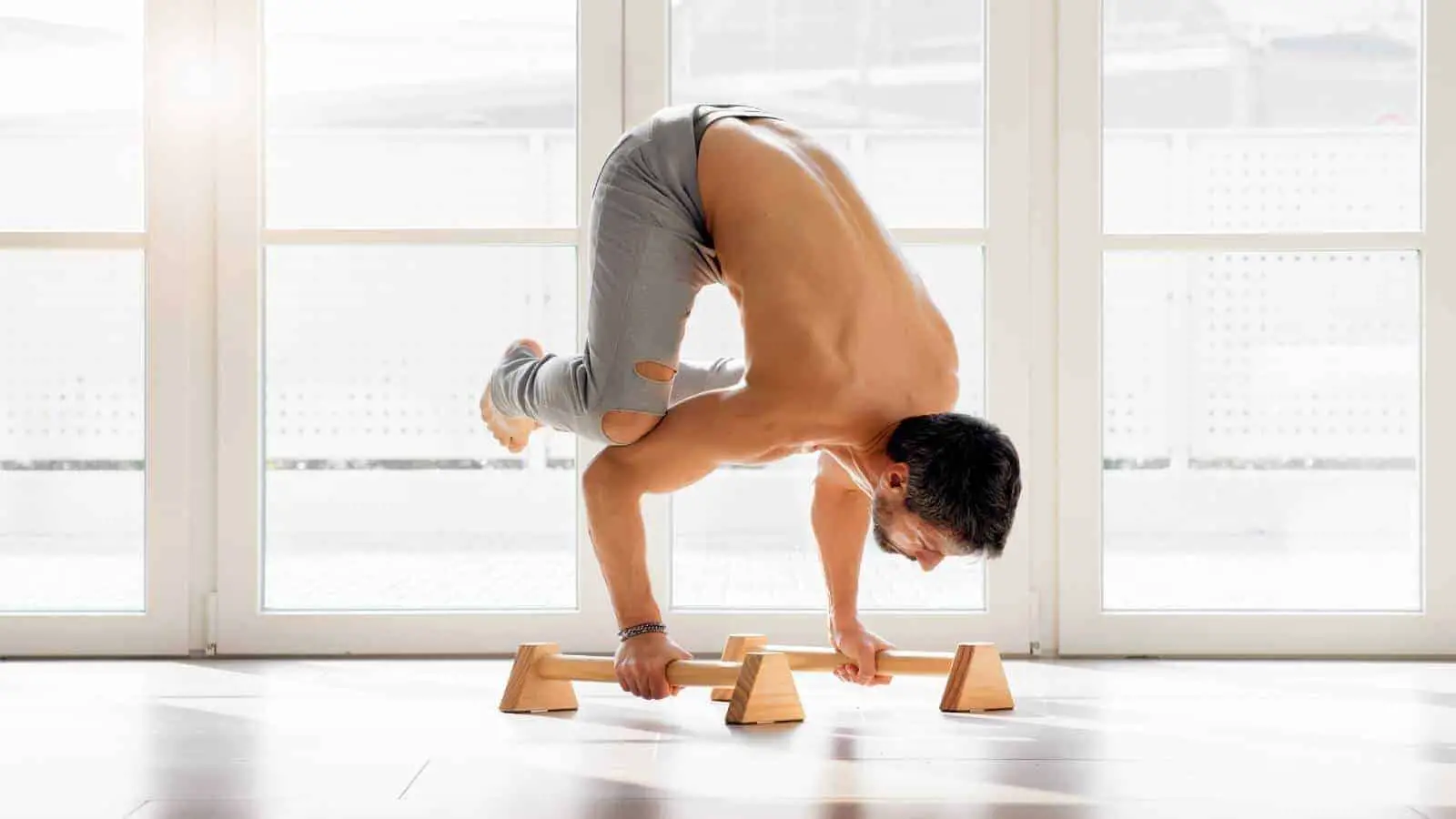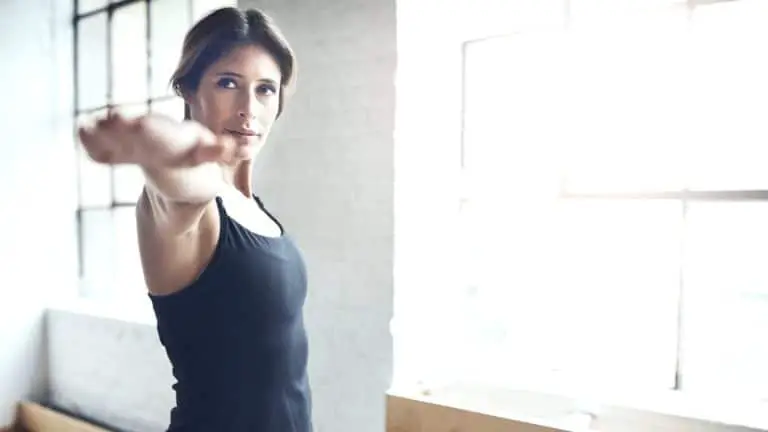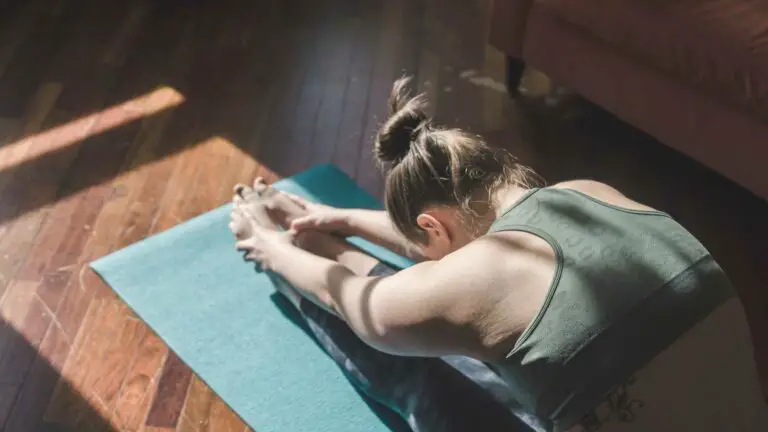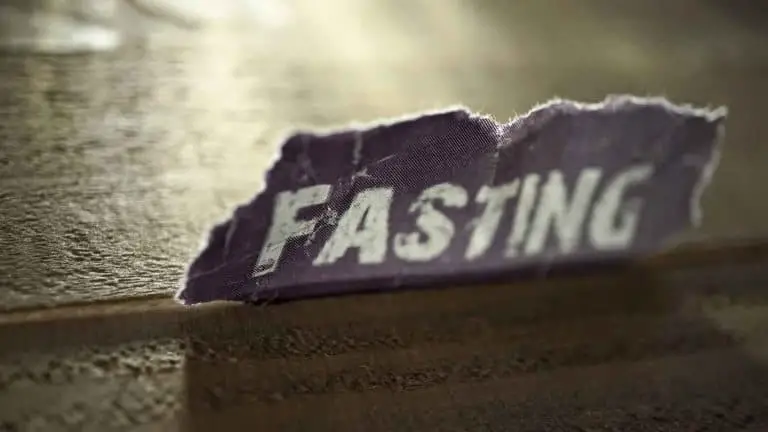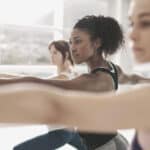At first glance, yoga and calisthenics may not appear like two disciplines that would go well together. Yoga seems so calm, while calisthenics seems much higher in intensity. However, these two practices can complement each other quite well, and combining the two can help you grow in either practice.
To combine yoga and calisthenics, you can bring exercises from each discipline together to form a new routine. Both of these practices require strength and balance, and using both yoga poses and calisthenics exercises can be a wonderful form of cross-training.
In the rest of this article, we will take a closer look at what these disciplines offer to each other and how to get started. We also have a few combinations of yoga poses and calisthenics exercises you can get started with today, as well as a few challenging ones you can work towards over time.
What Is Calisthenics?
Calisthenics is a type of exercise where you use your body weight to help build muscle and increase flexibility in a holistic way. Calisthenics is typically done without equipment, so it is a good pairing for yoga, which is also done just using your own body.
If you’re still wondering what calisthenics is exactly, you can think of moves like jumping jacks, sit-ups, lunges, squats, push-ups, and other exercises that can be performed without gym equipment. In comparison to yoga, calisthenics can be the more active and intensive of the two practices.
People who have been practicing calisthenics for a long time can do impressive exercises that require incredible strength, body awareness, and balance. This repertoire may include the “human flag,” where a person grabs hold of a vertical pole and holds themselves at a 90-degree angle to the pole as if they were a flag blowing in the wind.
If you’re curious to see the human flag in action and how someone even does a position like this, you can check out this Youtube video by Abnormal Beings:
If calisthenics is your primary practice, incorporating yoga positions into your routine will give you plenty of opportunities to work on your body awareness and balance needed for advanced calisthenic poses. It will also give you an active way to heal and restore your body. If you are a yogi first, you can bring some calisthenics to your practice to build strength more intensively.
Bringing Calisthenics and Yoga Together
If the unique benefits of both calisthenics and yoga appeal to you, combining these two practices is an excellent choice for your fitness routine. To help you get started, we have outlined here a few nice pairings of traditional yoga poses with classic calisthenic exercises.
We will start with some accessible beginner combinations and work our way towards advanced, challenging poses. You can use these more advanced poses as a goal to work towards over time and with patience.
Warrior Poses + Lunges
Bringing lunges into your practice of the different Warrior Poses is a great way to bring a little extra fire and burn to your time on the mat. Let’s take a look at how you can get started with this first combination.
Warrior I (Virabhadrasana I)
Begin in Warrior I. To move into this position, you will start standing and facing the front of your mat. From here, you will step your right foot back, placing your foot at a 45-degree angle. Your back leg will remain straight, while your front leg will bend 90 degrees at the knee, making sure your knee is placed over your ankle.
Once your feet are positioned correctly, check in with your hips. You should be facing forward, with both points of the hip shining forward to the front of the mat. Breath deeply here, and on an inhale, raise both your arms up overhead. Look up at the sky, breathing deeply. You are now in the first position of the Warrior series.
This pose is highly beneficial because it is impacting many areas of your body at once. It gives your chest and lungs a chance to stretch while it builds strength throughout your legs, arms, and shoulders. You can remember as you practice the various Warriors poses, you are practicing poses that are designed to combat the enemy of self-ignorance. Through practicing these postures, you are furthering your journey as a spiritual warrior.
Lunge
Now, it’s time to bring in the calisthenics. From your Warrior I position, you can easily move into a classic lunge. You can keep your front leg in its current position, facing forward and bent at the knee. You will want to slightly adjust your back leg, turning your foot to be facing forward. Your feet should be in line with your hips, saying they should not be on the same line. Your hands can be resting on your hips or even holding some weights at your side.
To perform the lunge, will you need to incorporate some movement. You will lower your back knee towards the mat from this position, keeping the toes of your back foot tucked under. From here, you will raise yourself back up to a standing position with both of the legs straight. You can repeat this motion, bending at your knees while lowering and then coming back up, several times on each side of the body.
This movement will give you a variety of strengthening benefits, mostly in your lower body. This includes both your glutes as well as your hamstrings, quadriceps, and calves. Since lunges will exercise one leg at a time, you will have a chance to focus on each side of your body. Practicing lunges is a great chance to work on your balance and observe differences between your right and left leg.
Warrior II (Virabhadrasana II)
After completing your set of lunges, you can transition back into your Warrior postures with the second posture of the series. To perform this posture, you will want your legs to be distant from each other as they were in Warrior I and the lunges, but now it is time to open your body to the side.
You can do this by turning your back foot to a 90-degree angle and adjusting your feet, so they are in a single line. With your front leg bent at the knee, let the expansion take place in your hips as you bring both arms out to the side, stretching lengthwise and parallel to the ground. You can look out over the fingers of your front arm while expanding energetically forwards and backward at the same time. Breathe here and feel the power of the second Warrior position.
This pose will stretch your upper body while continuing to strengthen your lower body. It will also give your internal organs gentle stimulation to improve their functionality and health. Performing this pose is an energizing act that can help you become more aware of your body’s flow of energy. Take some time to breathe deeply and observe the sensations in your body while in Warrior II.
Four-Legged Staff Pose + Plank
If you have attended a live yoga class or have followed some traditional flows at home, chances are you have performed a few Sun Salutations, or Surya Namaskar, in your yoga practice. Many traditional yoga classes will consistently begin with several cycles of Sun Salutations to warm up the body and prepare for the coming positions.
If you are familiar with this flow, you will most likely be used to moving from a plank position (also known as Kumbhakasana) further down into the Four-Legged Staff Pose or Chaturanga Dandasana. Both of these positions, as well as the transition between the two, is incredibly beneficial for strengthening the core as well as the arms.
You can use the natural flow of the Sun Salutation to create your own yoga/calisthenics combination. You can insert this into the series if you wish or isolate it to create a separate flow and strengthening exercise.
Plank (Kumbhakasana)
First, you will want to find yourself in a plank position. To correctly do Kumbhakasana, you will want your back to be straight. This means the whole backline of your body, from your feet to your head, will be in a straight line. Your arms are fully extended, so your upper body will be above your heels, but the point is for your hips to be neither too high or to sink too low.
Four-Legged Staff Pose (Chaturanga Dandasana)
As your core activates and keeps your body strong and firm in this position, it is time to transition to the Four-Legged Staff Pose. To do this, your body will remain in a straight line, but your arms will bend and, with control, you will lower your body down towards the ground. It is a bit like lowering yourself down in a push-up.
Hold yourself in a Four-Legged Staff Pose for a few breaths, making sure your body is parallel to the floor without touching. From here, you can transition back to Plank, keeping your body in that straight line. This movement is like a yogic-pushup, and you can repeat it several times to give your upper body a deep strengthening workout.
Boat Pose + Crunches
Adding some crunches to your time in Boat Pose is a great way to bring extra intensity to this particular yoga position. Let’s begin in Boat Pose and see what to do.
Boat Pose (Navasana)
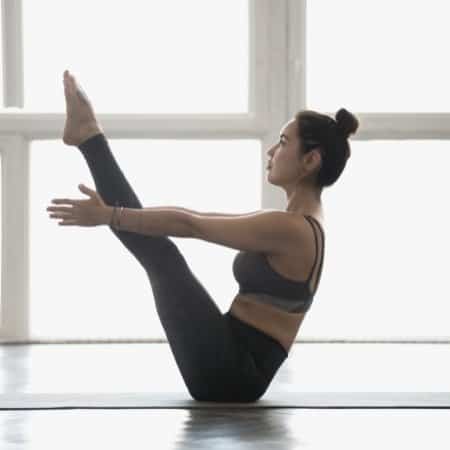
This pose has a few different variations you can work towards depending on your current core strength level. To begin any of the variations, you will need to start sitting on your mat, facing forward. From here, you can place your palms on the ground next to each of your hips, extending your legs out in front of you.
Next, you can lift your legs in front of you, starting with a bend in your knees and keeping your shins parallel to the sky. Your arms can extend forward on either side of your legs without touching as you work to balance on your sit bones. This posture will require great core strength, and even in this first modification, you will still be building muscle throughout your abdomen and in your back.
If you feel warmed up with sufficient flexibility in your hamstrings, try to extend your legs fully, raising your feet, so they are at about your eye level. You can continue to lift your feet until they are above your head, but there is no rush to get this far in the position. This pose is not only increasing your core strength but also your balance and concentration.
Crunches and Sit-Ups
From Boat Pose, you are well-positioned to add a few crunches for an extra ab workout. To do this, you can imagine yourself transitioning between the full boat pose, with your legs raised, to a Low Boat or Canoe pose.
To move into the Canoe position, you will extend your legs fully as you lower them to the ground. Allow your legs to hover a few inches above the ground without touching. As you are lowering your legs, also allow for your upper body to recline towards the floor. Hover above the ground, making sure your upper back does not make contact with the floor. Hold here for a few seconds, using your activated core to keep you balanced on your sitting bones.
Slowly, move between these two positions several times to incorporate the calisthenic movement. You can limit the range of motion here to practice crunches or extend fully if you wish to complete a set of sit-ups.
This movement is a fun and playful way to engage your core without becoming bored with the routine. Maintaining balance in both Boat Pose and the transition to Canoe Pose requires a lot of inner calm and concentration. Your mind won’t have a chance to wander away and become bored with the activity. By requiring the mind to stay present with the body, you can enjoy the full experience of this core strengthening workout.
Handstand + Inverted Push-Up
This exercise is a more advanced combination, but if you have a handstand in your practice, this can be a fun and intense way to bring some movement to the position. Let’s take a look at how to do this combination safely and effectively.
Handstand (Adho Mukha Vrksasana)
To do a handstand with extra support and stability, you can move your mat up against a wall in order to use the wall to catch you and help you find your balance. Begin in a downward-facing dog with the front of your mat facing the wall. Shift your weight, so it is more squarely over your hands, engage your core, and kick up one leg at a time.
If you are using the wall behind you, you can give yourself a powerful kick to get your lower body in the air without worrying about toppling over. From here, adjust your positioning so you can balance your body without the aid of the wall.
Mastering a handstand takes time and practice in any discipline. Keep returning to this pose if you haven’t learned it yet to continue to grow the strength and body awareness you need. Eventually, you will be able to easily move into a handstand on your own without wall support.
Inverted Push-Ups
Once you are able to find your balance in a handstand comfortably, you can bring in the extra challenge of calisthenics.
From a handstand, and slowly and with awareness, lower your body weight towards the ground while maintaining your balance. This will require strength in your shoulders and triceps as well as the ability to concentrate and maintain your handstand balance. Work towards repeating this push-up motion while keeping your body in the air.
If you aren’t quite at this level yet with your handstand, don’t worry. There are other exercises you can incorporate to build the strength you need to accomplish this yoga/calisthenics combination effectively. In order to get some ideas of activities that will help you build both the strength and balance you will need, check out this video by Chris Heria here:
Handstand (Adho Mukha Vrksasana) + Crow (Bakasana)
Another variation you can try is moving from your handstand to crow and back again to your handstand. This is an advanced level of yoga/calisthenic work but is certainly something you can accomplish.
Begin in a handstand, and with your core strength and activated, slowly bring your legs in towards your core as you bring your lower body back down towards the ground. This should be done with great control. As your legs come closer down to the ground, bring your knees to your upper arms, tipping forward at the pelvis to go into Crow or Bakasana.
Rest here in Bakasana for a moment, keeping yourself focused on what is happening in your body. Then, slowly bring your legs away from your arms and extend them back into the air to return to your handstand position. Doing this cycle once effectively will take a great deal of strength, balance, and skill. It can be a goal you work towards as you deepen both your yoga and calisthenics practice.
For more ideas on how to bring classic calisthenic exercises into your yoga practice, you can check out this inspirational video by TrainingPal here on Youtube:
Is calisthenics part of yoga?
Now that we have explored how we can get started bringing yoga and calisthenics together, we can look at the why. Why do these two practices complement each other so well and help lead to new growth and depth in one’s primary practice? Let’s take a look at a few of the reasons.
The Approach
One common factor between the practice of yoga and calisthenics is the approach. For a complete beginner, either practice can seem inaccessible or even impossible from the outside. However, both of these disciplines require long-term patience and dedication. Through the process of showing up every day to continue your practice, you begin to make progress and discover some of your once-unknown physical powers.
Both of these practices have advanced postures that can bring the same allure and frustration to the practitioner. Likewise, they will both give you the chance to grow mentally as you let go of the limiting beliefs you are holding about yourself and reprogram your mind to allow yourself to achieve more than what you thought was possible.
Both of these practices rely on the power that is already inside of you. There is no need to buy any fancy equipment or have access to any particular training facilities. Both practices give you the chance to explore your body and unlock hidden potentials all in the comfort of your own living room.
Feel Playful
Part of this approach is the power to harness your inner child. The poses you will end up practicing in both of these disciplines can invoke the feeling of playfulness that can be a powerful antidote to the stresses of the modern world. Attempting headstands, falling over, and attempting again can bring you back to playful days as a kid where things weren’t so serious. Approaching these postures in this way gives you added joy and freedom to your practice time.
Both practices will help you develop a deeper awareness of the factors that must come together to achieve these challenging, fun poses. For example, to stay in a headstand, your mind simply cannot be thinking of anything else except where it is in that moment. If you start thinking of what you’ll make for dinner, your balance will most likely begin to shift, and you’ll find yourself toppling over.
It’s not just core strength and a developed sense of balance that you will need to complete these poses, but a calm mind as well. By repeated practice, you will learn how to calm your mind and bring your focus inward to access advanced postures. Both disciplines are similar in this way and offer the practitioner many lessons to explore their own abilities in both mind and body.
For the Athlete
By combining yoga and calisthenics, you have created a tool that will develop your body in ways you are most likely not doing in your main sport. Yoga and calisthenics both focus on building muscle overall in your body, and yoga specifically will grow your flexibility and range of motion.
Better strength and flexibility is an asset in general in life as you want to keep your body healthy, capable, and free of aches and pains. No one likes the feeling of feeling winded by walking up some stairs or feeling stiffness in the knees from a lack of flexibility in your hips.
However, the strength and flexibility that the combination of yoga and calisthenics provides are beneficial for the athlete. No matter what the primary sport is, using yoga and calisthenics together is an amazing cross-training tool that will help keep your body balanced and healthy. It will also bring you added mental health benefits that you may or may not be receiving in your primary workout.
Tips to Get Started With Yoga and Calisthenics
Here are a few additional notes to help get you started with your first crossover routine. Remember these tips on days you are feeling frustrated with your progress or feeling a little bit off. This is all part of the practice and simply needs to respond to kindness, compassion, and unwavering commitment.
- Listen to your body. As with any practice, check-in with your body each day and respond accordingly. Your body will tell you when it needs to rest, when it needs restorative practices or when it has the energy and is ready to be challenged. Tune into your own needs and respect them when it comes to planning your workouts.
- Be patient and be committed. Growing either of these practices takes time, practice, and commitment. Remember to be consistent, showing up for yourself day after day, and the growth will come. Be patient and allow the poses to come in their own time. There is no need to rush; there is only the need to practice.
- Celebrate your victories. As you make progress and achieve new things along the way, don’t forget to take these small victories as an opportunity to reflect on how far you have come and what this journey has taught you. Achieving a new pose is exciting not necessarily because of the pose itself but because of the ability to achieve something that you may once have thought was impossible.
Final Thoughts
Combining yoga and calisthenics is an inspiring opportunity to inject some new life into whatever your primary practice is. For a long time yogi, the world of calisthenics can be an invigorating, inspiring place. For the long time practitioner of calisthenics, yoga can offer reflective, restorative power they have been seeking. Either way, bringing these practices together is a great way further to explore your own body and innate human power.

